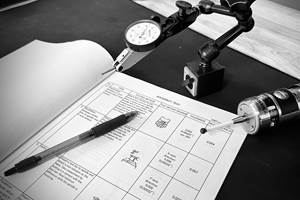The Right Gage for Measuring Small Bores
Small bore holes present a unique set of challenges for precision measurement, but small mechanical bore gages can be used for tight tolerances in this application.
Share






Over the years, this column has examined using air gaging and back pressure to measure small bores (under 1 mm/0.040 inch). Air gaging can be an acceptable way of measuring small bores, but it does not provide any form information; it only provides the flow area as related to the diameter. However, because these holes are so small, there may not be another economical solution.
Increase the size, though, and there is a whole family of bore gages available for measuring holes that range from 1 mm to 20 mm; in other words, a whole family of bore gages for these small bores. These precision mechanical bore gages use comparison to determine the size and shape deviations of bores. Unlike fixed plug gages that employ a ground cylinder and sensitive contact to compare a bore to a master, these small, comparative gages basically take the mechanical transfer out of the plug and use it as a standalone probe to measure small bores. Since there is no centralizing plug, the small-bore probe is rocked through the bore being measured to capture the smallest value related to the diameter of the bore — very much in the same manner as the tried-and-true adjustable bore gage.
Welcome! You鈥檝e unlocked premium content.
The big difference — or perhaps the small difference — is that this type of probe bore gage can measure bores a lot smaller than the normal, adjustable bore gage. The adjustable bore gage is just as its name implies: adjustable to cover a large range of parts, but with a very limited measuring range. For example, a small-bore probe with a nominal size of 1 mm will measure a bore from 0.95 to 1.15 mm; a nominal 10 mm probe can measure 9.4 to 10.6 mm; and a nominal 20 mm probe can measure 19.4 to 20.6 mm bores. Though limited in range, these bore probes have repeatability better than 1 μm and will be accurate to 1% of the measuring range.
So, what is really happening with these small-bore probes? As noted, they operate very similarly to fixed plug gages. There are two sensitive contacts held with flexures. As the contacts change with bore diameter, they transfer the size via a tapered pin to the indicating device. The indicators can be a dial, digital indicator or comparator, or even a linear variable differential transformer (LVDT) probe and amplifier.
As with any comparative gage, these small probe gages require a setting master. The user of these bore probes will place the master on the bore probe and rock the bore plug in a side-to-side manner, observing the indicator readout and watching for the reversal point, or the smallest value. The user will then set this point to zero or the nominal size. Once set, the gage is taken to the bore to be measured and the same rocking process is used to find the diameter. With today’s digital indicators, this process can be easier since many digital indicators have dynamic memories that can latch upon the minimum value, eliminating the need for the user to remember the reversal point.
These probes can be used in special stands that will orient the small-bore probe to the part and lower it into the bore. When used in this manner, the bore does not have to be rocked, as the probe is square to the bore because it is self-centralizing and will therefore provide the actual diameter deviation.
Like fixed plug gaging, the probes are available in through- and blind-hole configurations and with chromed contacts for normal wear conditions, or a diamond-like coating for extreme wear applications.
Small probe gages are often the only means of precisely measuring bores from 1 to 5 mm. In the hands of an experienced user, they can provide the results needed for tight tolerance bore measuring applications.
Related Content
6 Machine Shop Essentials to Stay Competitive
If you want to streamline production and be competitive in the industry, you will need far more than a standard three-axis CNC mill or two-axis CNC lathe and a few measuring tools.
Read MoreRethink Quality Control to Increase Productivity, Decrease Scrap
Verifying parts is essential to documenting quality, and there are a few best practices that can make the quality control process more efficient.
Read MoreThe Link Between CNC Process Control and Powertrain Warranties
Ever since inventing the touch-trigger probe in 1972, Sir David McMurtry and his company Renishaw have been focused on achieving process control over its own manufacturing operations. That journey has had sweeping consequences for manufacturing at large.
Read More4 Ways to Establish Machine Accuracy
Understanding all the things that contribute to a machine’s full potential accuracy will inform what to prioritize when fine-tuning the machine.
Read MoreRead Next
How I Made It: Dennis Rymanowski
Dennis Rymanowski has worked at NSH USA for 60 years, with his passion for manufacturing living alongside his passion for his family’s polka band.
Read MoreA New Frontier in Surface Finish Control
What if your machine tool could measure surface roughness as it cuts? This article explores how in-process metrology is advancing from concept to reality, enabling real-time feedback, immediate detection of anomalies and new levels of control over surface quality. Discover the technologies making this possible.
Read More




















